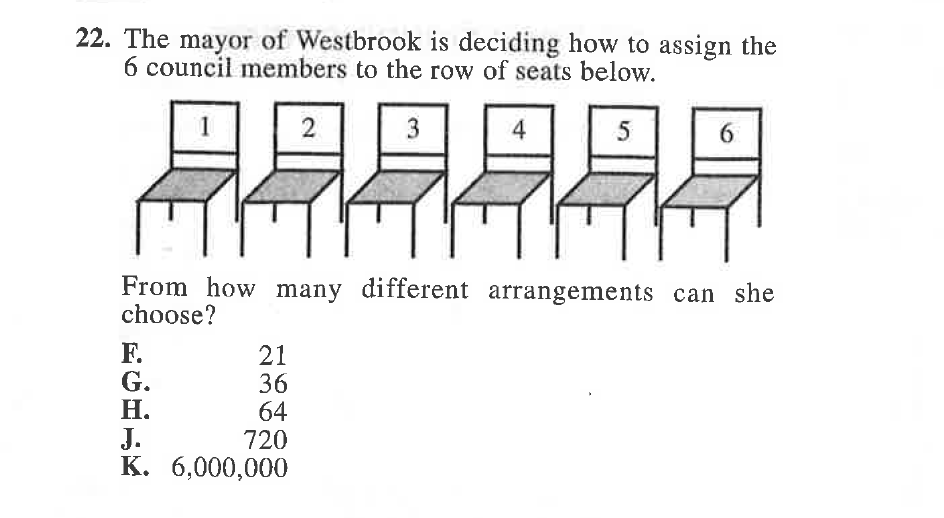ACT Math Prep: Probability on the ACT
The ACT math section examines students mainly on their knowledge of concepts learned in algebra I, geometry, and algebra II. However, there are a good number of other questions that test students on areas that are broader than these course materials. For instance, students are given a handful of questions related to statistics and probability. Here, we’ll walk you through what types of probability questions you can expect to see on the ACT and how you can make sure to be fully prepared to conquer them on test day.
ACT Math Overview
The ACT math section can be difficult and frustrating for many students. Questions range from testing students on probability and statistics to algebra, algebra II, geometry, trigonometry, and more. Questions are ordered from easiest to hardest, and, as time goes on, students can become increasingly frustrated as questions become very complex.
In addition to difficult questions, the ACT math time constraint is pretty intense: 60 questions in 60 minutes. That means you have one minute for each question on the exam. The math section tests students on concepts that are mainly covered in high school statistics, algebra, geometry, algebra II, and trigonometry courses. Many students will not have reviewed all of these concepts in quite some time when they begin their ACT test prep, so the first step to combatting the ACT math section is to brush up on the concepts tested. You can do this by completing practice tests or working through sample problems on the ACT website.
Once you’re able to consistently work through the majority of the types of questions and topics that show up in the math section, it’s time to think about overall ACT math strategy to help you be effective with the time constraint. Assess whether your testing pace on this section is appropriate for the time constraint, and go from there to determine what other strategies and tips and tricks you should keep in mind to help you move quickly through the problems.
As you practice the ACT math section, you’re likely to see some patterns in the types of questions that you’re missing. For most students, there will be a clear indication of which areas of math should be revisited and drilled leading up to test day. For a lot of students, these are simply the areas related to classes that they have not taken in a few years. For other students, these may be areas that they’ve struggled with in school as well.
It’s important to focus on the areas that you’re struggling with. It makes a lot of sense when you think about it: the areas holding you back are the ones you should spend your time drilling and preparing for. This is going to help your overall progress more than continuing to practice areas that already make sense to you.
Probability & Stats on the ACT
Many students spend so much time fixating on the algebra, geometry, algebra II, and geometry questions that show up on the ACT that they forget to practice some of those other areas that are tested. One such area is probability questions.
Some students will take stats courses during high school, but for many, this is not typical. It is common for areas of stats and probability to be weaved into most math classes that students take, starting way back in elementary and middle school.
For that reason, we’ve compiled some practice ACT probability questions to help you brush up on this area leading up to test day. Check out some example ACT probability questions below. Like all concepts tested, questions range from “easy” to “hard.”
If you find these questions easy to work through, good for you! That means these problems should not be the focus of your ACT math prep. However, if you find these questions difficult, make sure that you plan to spend more time on stats and probability practice leading up to test day, as there are generally about 6 questions on the test.
Example ACT Stats & Probability Questions
Before we look at this first example, lets start with defining what “probability” actually means. The probability of a specific event can be determined by calculating the desired outcome divided by the total possible outcomes.
Probability = desired outcome / total possible outcomes
Lets take an easy example:
There are 10 marbles in a bag. There is only 1 red marble. What is the probability, or the likelihood, that you draw the red marble on your first try? 1 out of 10. To calculate this, you would take the desired outcome (drawing red on the first try, which only has 1 possibility) and divide it by the total possible outcomes (there are 10 total marbles, so that is the total number of possibilities).
For the ACT, probability questions can show up early on and be pretty straightforward, and they can also show up later in the test and be a lot more complicated.
Question #1 below is the first question on an ACT exam. This is meant to be an easier ACT math question, but there are still a few steps to thinking through it.
What do we know? We know that there are 32 people in the French club. We know that there are 5 club officers. We know that the new representative CANNOT be one of the 5 officers.
What do we want to find out? What is the likelihood that a member of the club, Luis, will be chosen as the representative. Luis is not one of the 5 officers.
So we can start by identifying the desired outcome: Luis is chosen as the representative. How many possibilities of that happening? Just 1. There is only 1 Luis, so the total desired outcome is 1. Our numerator in our equation will be 1.
Then we need to identify the total possible outcomes. We have to eliminate the 5 officers from our calculation, since we know they are ineligible for the representative spot. That leaves 27 members that could be chosen as the representative. This is our total possible outcomes. Therefore, our denominator is 27, and the correct answer to this question is C.
Lets assume a couple of different questions had been asked for the question #1 above.
What if the question had also talked about Mary, another French Club member that is not an officer? Lets pretend the question had been: What is the probability that Luis OR Mary will be appointed as representative?
To work through this question, the only thing that changes is our numerator, which is our DESIRED OUTCOME. Now, we have 2 different possible ways of fulfilling this outcome, so we ADD the two people together. Your equation would be 1/27 + 1/27 = 2/27. This answer would be 2/27.
What if the question had said that the club will appoint TWO representatives and asked what the probability would be that BOTH Luis and Mary would be appointed.
Now we have multiple events that are DEPENDENT. We need BOTH of them to happen together. Therefore, instead of using addition, we need to use MULTIPLICATION. Additionally, we need to alter our denominator, the total possible outcomes, after the first step, as the total remaining qualifying students will have changed. Your equation for this question would be 1/27 * 1/26 = 1/702. (1/27 = the likelihood that Luis is chosen; 1/26 = the likelihood that Mary is chosen — we have to lower the total to 26 because Luis is already accounted for in the first part of the equation.) This computes to approximately .14%, which means there is a very small probability that Luis and Mary will both be chosen for these slots.
The next example is also dealing with probability, but rather than having you calculate, the ACT is tasking you with understanding the probability and expressing it.
A key thing to pay attention to with probability questions, particularly those that inquire about drawing marbles (or balls or cards or dice, etc.) out of a bag, is whether or not the item is being REPLACED.
If the item IS being replaced, your total possible outcomes (Denominator) will remain the SAME.
If the item IS NOT being replaced, your total possible outcomes (Denominator) will have to be deducted by however many items are removed with each prior draw. We saw this in the question above where we lowered the denominator from 27 to 26 because Luis had been removed from the qualified candidates pool.
Take a look at the sample question #34 below. We are once again dealing with marbles being drawn out of a bag, but this question is quite a bit more complex than the one we just went through. In fact, this question doesn’t even require you to do math to determine the answer.
In this question, we’re not given the total number of marbles in the bag. All that we know is that a red marble is drawn every time and the marble drawn IS replaced after each draw.
*Hint: it can be strategic to use process of elimination to help you work through questions like these — rule out the answers that don’t work.
The key to this question is in the phrase “with replacement.” If the marble is being replaced every time, it is possible that it is the SAME RED MARBLE being drawn each time. Therefore, the only thing we can assume is that there is ONE red marble. There may be more, but we don’t have enough information to prove it. The correct answer is F.
Combinations & Permutations
Another area of statistics and probability that students can expect to be examined on during their ACT exam is combinations and permutations.
Both combinations and permutations deal with the total number of possibilities of a specific event occurring.
An easy combinations example is the outfit question: Bob has 3 pairs of pants, 2 shirts, and 1 pair of shoes. How many different outfits can Bob create if an outfit includes one of each item?
Your task is to calculate the TOTAL number of outfit options that Bob has. You can do this by using simple multiplication: you multiply each number of possibilities by each other.
Bob’s total possible outfits = 3 pairs of pants x 2 shirts x 1 pair of shoes = 3x2x1 = 6 total outfits
This is a COMBINATION because we don’t care about the order of the operations — if Bob wears his blue pants, yellow shirt, and brown shoes, this is the same outfit as his brown shoes, blue pants, and yellow shirt. The order DOES NOT matter.
A PERMUTATION is an ORDERED COMBINATION.
Basically, this means that permutations occur when a combination has to happen in a specific order. A great example of this is your locker combination. Lets say your combination is 15-24-04. Your locker WILL NOT open if you key in 24-04-15 or 15-04-24. In this case, each of the sets of 3 numbers just listed is a DIFFERENT combination. The order matters significantly, so you are dealing with a PERMUTATION.
Question #22 below deals with a combination. There are 6 council members, and we need to figure out how many different ways we can seat them in the 6 chairs.
If you think back to how we calculated Bob’s outfits, you’ll remember that we used multiplication and simply multiplied the number of possibilities for each slot: pants, shirts, shoes.
Here, we can use a similar approach, but, rather than dealing with items of clothing, our slots are replaced with 6 chairs.
Therefore, we need to figure out how many possibilities there are for each chair.
Chair 1: How many different people can sit here? 6 different people can sit here.
Chair 2: How many different people can sit here? 5 different people can sit here because 1 person has to already be sitting in Chair 1.
Chair 3: How many different people can sit here? 4 different people can sit here because 1 person has to already be sitting in Chair 1 and 1 person has to already be sitting in Chair 2.
and so on…
So, your combination would be like this:
Chair 1 x Chair 2 x Chair 3 x Chair 4 x Chair 5 x Chair 6 = 6x5x4x3x2x1 = 720
There are 720 different ways that these 6 people could be ordered to sit in these chairs. The correct answer is 720.
In looking at question #22 above, there are also different variations of this question that the ACT could ask. For example, they could say something like “Candidate 1 has to sit in Chair 1.” Now how many different ways are there that the candidates could be ordered in the chairs?
The difference between this question and the original is that now Chair 1 only has ONE option for who can sit there. Therefore, your calculation for this question would turn into 1x5x4x3x2x1 = 120 ways to sit the other 5 candidates in chairs 2-6 if Candidate A is in Chair 1.
Question #30 below is another question about combinations and permutations. If you stop to consider the format of your answer options for a moment, you’ll see that two of the options contain an answer with P and the other three contain answers with C. This tells you that, not only do you have to figure out the equation, but you are also being tested on whether or not you can identify if the calculation is a combination or a permutation.
Lets take a look at the question. We can break this question into two parts: the women and the men. We have 5 women to be selected out of a total pool of 12. We also have 5 men to be selected out of a total pool of 18.
Again, we can turn to multiplication. For the women, there are a total of 12 women that can sit in committee seat A, 11 women for committee seat B, 10 women for committee seat C, 9 women for committee seat D, and 8 women for committee seat E.
For the men, there are a total of 18 men that can sit in committee seat A, 17 men that can sit in committee seat B, 16 men that can sit in committee seat C, 15 men that can sit in committee seat D, and 14 men that can sit in committee seat E.
Given our question, we don’t actually have to calculate the total number of combinations we can make, but we certainly have enough information to find this. For the women, you would multiply committee seat possibilities for seats A-E, and for men you would do the same thing. Your equations would look like this:
Women: 12 x 11 x 10 x 9 x 8 = 95,040 different combinations of women that could be created from the 12 original women to fill the 5 seats
Men: 18 x 17 x 16 x 15 x 14 = 1,028,160 combinations of men that could be created from the 18 original men to fill the 5 seats
To get to the answer of the question above, we need to go back to thinking about combinations versus permutations. Which one is this example?
Think back to Bob’s outfit: brown shoes, yellow shirt, and blue pants is the same outfit as yellow shirt, blue pants, brown shoes. The order does not matter, so that is a combination.
In contrast, your locker combination 10-20-30 is not the same as locker combination 20-30-10, so this is a permutation.
For this example, would the two sample committees below be the SAME or DIFFERENT?
SAMPLE COMMITTEE 1
WOMAN 4
WOMAN 8
WOMAN 11
WOMAN 2
WOMAN 9
SAMPLE COMMITTEE 2
WOMAN 2
WOMAN 9
WOMAN 4
WOMAN 11
WOMAN 8
The answer is YES, these two committees are exactly the same. The women are all the same, regardless of the order they are put into. Therefore, this is a COMBINATION because the order does not matter.
The correct answer to question #30 is K. You can eliminate answers F and G because you know this is a combination and not a permutation. Then you can eliminate answers H and J because we are told in the question that we are dealing with two separate committees: men and women. Therefore, we never combine all of the candidates, so we do not ever use the value 30.
Well, there you have it! Everything you need to know to work through the types of probability questions that you could see on ACT test day.
LOOKING FOR MORE ACT MATH SUPPORT? I’VE COMPILED A FREE GUIDE OF ALL THE KEY FORMULAS THAT YOU’LL WANT TO HAVE MEMORIZED FOR TEST DAY. YOU CAN ACCESS THE GUIDE BELOW.
INTERESTED IN TUTORING?
Working one-on-one with a test prep & college counseling expert can help you maximize your score on test day and get accepted to your dream school. Whatever your college prep goals, our team can help!
I want to sign up! - Set up online lessons using the link to our scheduling system.
I want more information! - Fill out the information in the link, and someone will reach out soon.






